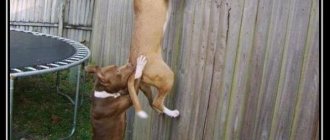What makes a dog run away from home?
Any dog, even the most educated and trained one, will run away or at least leave the yard if given the opportunity. Another question is how quickly will it return and will it come back at all? It all depends on the reasons that force the four-legged friend to leave his native abode.
Take precautions against your dog escaping in advance
Males can overcome imaginable and inconceivable obstacles by sensing a flowing bitch. Not least of all is the tendency to wander. In principle, any breed of dog can become a runaway, but sled dogs and hunting dogs are more susceptible to this due to their innate desire to pursue. Vagrancy is more typical of shepherd breeds and mongrel dogs. More often it is associated with a lack of work, social connections and new information. Guard breeds have a very strong sense of territoriality, so they rarely run away.
All previous reasons are often associated with boredom. Once escaping from the “cage”, the animals understand that things can be much more interesting behind the fence, and after walking around, they usually return, but they can end up in someone else’s yard if they see that it is better there, or get lost. Just like in humans, dogs' orientation instincts are developed to varying degrees.
At what age can castration be done?
Veterinarians working in animal shelters are most often inclined to earlier castration. After all, it’s easier to place the puppies later. Therefore, in dog shelters they castrate after 2 months of age.
Breeders and dog breeders insist on a later date - from 14 months and older. This is explained by the fact that the body that has not suffered an injury develops more fully before a certain period, has better health and stronger bones. All are united in one thing - the operation must be carried out before the first mating.
Dogs that have not tasted sexual pleasures tolerate intervention more easily. age for castration of dogs has been conditionally chosen - 6-12 months. At later stages, the animal may still have instincts, and along with them unpleasant behavioral characteristics - a craving for sexual hunting and a desire to mark objects.
What to do if the dog tries to run away
Fix flaws in the fence. If the “mole” has learned to dig tunnels, they make a trench under the fence and dig in large stones, a curb, or pour a narrow strip foundation about 30 cm deep without formwork. The chain-link mesh is lowered and dug into the ground. The lower edge is fixed in the ground in any convenient way. Often dogs jump over the fence if, for example, there is a booth or firewood stacked under the fence. In this case, you can try to remove the improvised step. It is more difficult if the “athlete” overcomes the fence from the ground. Here you need to either increase its height or build a “bumper”. A small canopy on the inside of the fence. It doesn't have to be solid. It is enough to place an obstacle in the form of a wooden block or a metal corner at a short distance from the top edge of the fence.
Example of a fence with a corner at the top
There is no point in experimenting with barbed wire. A dog will still jump and may get hurt, but a very persistent dog will not analyze and learn from its mistakes. If the dog has learned to open the gate itself, installing a small latch or hook will help. Abroad, where two-meter fences are not in fashion, dog breeders actively use electronic fencing. It consists of posts with sensors and an electric shock collar. In an attempt to run outside the perimeter, the dog receives a nasty electric shock.
Eliminating the possibility of escape is the main task. Of course, you can put an animal on a chain or lock it in an enclosure, but will a “life sentence” be fair to a faithful friend?
It is difficult to say how to stop a dog from running away, but you can do everything possible to prevent it from wanting to do so. Therefore, the next step should be to eliminate the cause of escapes and organize leisure time:
- Castration or sterilization will solve the problem of love sprees;
- You need to spend more time with the dog, take it for walks outside the yard, and be sure to play active games in the yard. Provide the opportunity to communicate with relatives. Walked and tired, she will be less eager to cross the fence;
- Provide leisure time while the owners are away. The dog is given toys that you can make yourself. Before leaving, you can hide them around the yard in different places. Somewhere, instead of a toy, you can put a treat. First, they play “search” with the dog. Having mastered the rules of the game, in the absence of the owner the animal will periodically check the places where the “treasures” were previously located.
- Praise cannot be punished. In this sentence, it is important to place a comma after the word “praise.” An attempt to escape should not be stopped with punishment, only with a treat or a game. And even more so, scold for returning, causing negative associations associated with home.
A collar with a GPS tracker will help you find a fugitive
Pros and cons of castration
Before deciding to take this step, you need to weigh the pros and cons.
Castration of dogs, advantages:
- Total disposal of unwanted puppies. Believe me, it is better to solve the problem radically than to place the kids in shelters or, even worse, to get rid of them.
- The dog's unnecessary agitation and aggression disappear, and his mood is stable.
- Dogs do not run away from their owners in search of a potential partner, and also do not fight over him.
- Your pet listens better, the relationship becomes closer.
- There are no unpleasant odors after the marks.
- The risk of prostate disease and ovarian cancer is reduced.
Disadvantages of castration of dogs:
- The dog is capable of gaining a lot of weight. But this can be controlled by walking more and eating less.
- There may be some health issues: thyroid disease, oncology in the genitourinary system and blood vessels.
- In old age, a dog may acquire dementia, or memory loss and disorientation in space.
- The texture and growth of fur changes.
- And a few words about the disadvantages of early castration: possible bone diseases (even cancer), urinary incontinence in old age, as well as the risk of a delayed infantile state of the dog. Simply put, an early neutered dog can behave like a stupid puppy all his life.
If the dog has already run away
If the dog is trying to run away or has already done so, owners can take steps to help find the reveler faster:
- Leave tasty food and water in the yard for the dog, and if possible, do not close the gate tightly.
- Wear a collar with a GPS tracker. This device is not a cheap accessory, but allows you to track the location of an animal through an application on a smartphone with an accuracy of up to 5 m.
- Hang a pendant with the owner's address and phone number on the collar. It looks like a small iron tube into which a piece of paper with contact information is inserted.
- The practice of chipping in our country is not as widespread as abroad, but it has its advantages. The microchip is inserted under the skin, usually in the withers area, and has its own individual number, which is read by a special scanner. This number is entered into the electronic database along with the data of the dog and owner. It is a kind of identification number and proof that the animal belongs to a specific person. If the lost animal is found and brought to the veterinarian, and he has already been warned about the loss of a similar animal, he will be able to check the serial number and, if there is a match, report it.
Final thoughts
That's all. A complete guide that will show you all the possible causes of jumping behavior in dogs and how to deal with it.
With this information, you can accurately determine the reason why the dog jumps on its owner. All you have to do is pay close attention to the circumstances of the jumping and you can completely eliminate this behavior!
Sources:
- https://www.akc.org/expert-advice/training/how-to-stop-your-dog-from-jumping-up-on-people/
- https://dogtime.com/dog-health/dog-behavior/1510-dog-training-behavior-jumping-up-dunbar
How to find a runaway dog
Success in finding a lost item largely depends on the speed of reaction. You need to act immediately:
- You need to notify all your friends and neighbors about the loss. Don't be shy about asking passersby. Children who are more curious and observant, as well as local dog walkers, can be good helpers. You need to take business cards with you or prepare pieces of paper with contact information in advance. Sometimes people cannot immediately figure out whether they have seen such a dog or whether they will see it later, and then they can immediately call.
- Printed advertisements are usually posted on entrances, bus stops and poles. Ideally, they should have a photo of the animal. On tear-off pieces of paper with a phone number there should be the inscription: “the dog is missing and a mini photo of the animal.” The reward can serve as a good motivation, but it has a clear disadvantage - calls from scammers begin to pour in. You should never give money in advance, much less transfer it to any cards or accounts, without making sure that the information is accurate.
- Social networks are an indispensable resource when looking for four-legged friends. Information about a missing dog with a good quality photograph and an accurate description will quickly spread if you ask those who care to repost it. There are also specialized websites that post advertisements about found and missing dogs. You can register for the duration of the search and subscribe to the newsletter about new advertisements.
- Notify local clinics and shelters about your missing dog. If it is chipped and stolen, the doctor will be able to read the chip number and, if there is a match, notify the true owner.
If a dog runs away from home and does not return to command, this is already an obedience problem. It needs to be solved by training. Any advice without the desire to work with the animal will come to naught, as will attempts to explain that there is no need to run away when there is a convenient loophole in the fence.
The price of castration
The cost of an operation in a clinic depends on the choice of anesthesia, the weight and age of the animal, the choice of all preparatory and postoperative procedures, and of course, on the status of the clinic. In addition, the location of the operation is taken into account - some call a veterinarian at home for this purpose.
Basically it ranges from 2.5 to 6 thousand rubles. But the price of dog castration , we repeat, even depends on the city where you live. It is also necessary to take into account the cost of travel and accommodation for the dog in the clinic after the operation.
Preparing for surgery
Please note that self-respecting specialists will not undertake to castrate a dog on the day of treatment. At the clinic, the animal must take blood and urine for analysis, perform an ultrasound diagnosis of internal organs, and check the function of the heart. The preparatory period will not require any special procedures, but nevertheless you should take it seriously and follow the recommendations.
1-2 months before castration
It is important that the dog's body is free of parasites. Even if your pet does not have obvious signs of internal or external pests, in preparation for neutering you should take preventive measures against worms, fleas and ticks.
After getting rid of parasites, the dogs are given the missing vaccinations. Make sure your pet is vaccinated against rabies, distemper, parvovirus enteritis, hepatitis, parainfluenza, piroplasmosis, leptospirosis, microsporia and trichophytosis.
3 days before castration
When there are several days left before castration, the dog must adhere to proper nutrition. Pets are transferred to light food. Dietary dry foods or natural foods are suitable - lean meat and fish, vegetables, dairy products. Cereals are kept to a minimum, fatty and floury foods are strictly prohibited.
The day before castration
The dog stops feeding 10-12 hours before castration, and water 4-6 hours before castration.
Carry out a general cleaning of the house - the animal should recover after surgery in cleanliness and comfort. Don't forget to dust and wash the floors with disinfectant.
Pack your bag for the clinic in the evening. Standard list of things: carrier, bedding, paper napkins, antiseptic and a special collar. Ask your veterinarian in advance for the name of a suitable antiseptic, and it is also possible that some of the listed items will be given to you on the spot.
Keep a positive attitude and be attentive to your pet!
Insufficient loads as a reason for fixating on “one point”
To survive, an ordinary dog or wolf in its natural habitat is forced to:
The domestic dog spends most of the day lying in a cozy bed. She does not need to hunt - the owner regularly supplies food. He is not given the opportunity to fight within the pack; there is no reason or the owners do not allow him to fight with his fellow tribesmen outside the walls of the house. But the body of a domestic dog is not much different from the body of, for example, a wolf - energy is produced taking into account the needs listed above. It is not surprising that many dogs that do not receive enough physical and emotional stress become hyperactive sexually. This is an outlet where the body “drains” excess strength that simply does not fit in the body of a dog that is forced to spend most of its time lying on the sofa. Therefore, for comfortable coexistence with an uncastrated male dog, you need to accustom yourself to go for walks every day: either long exercise on foot, or active games with the owner or fellow tribesmen.











